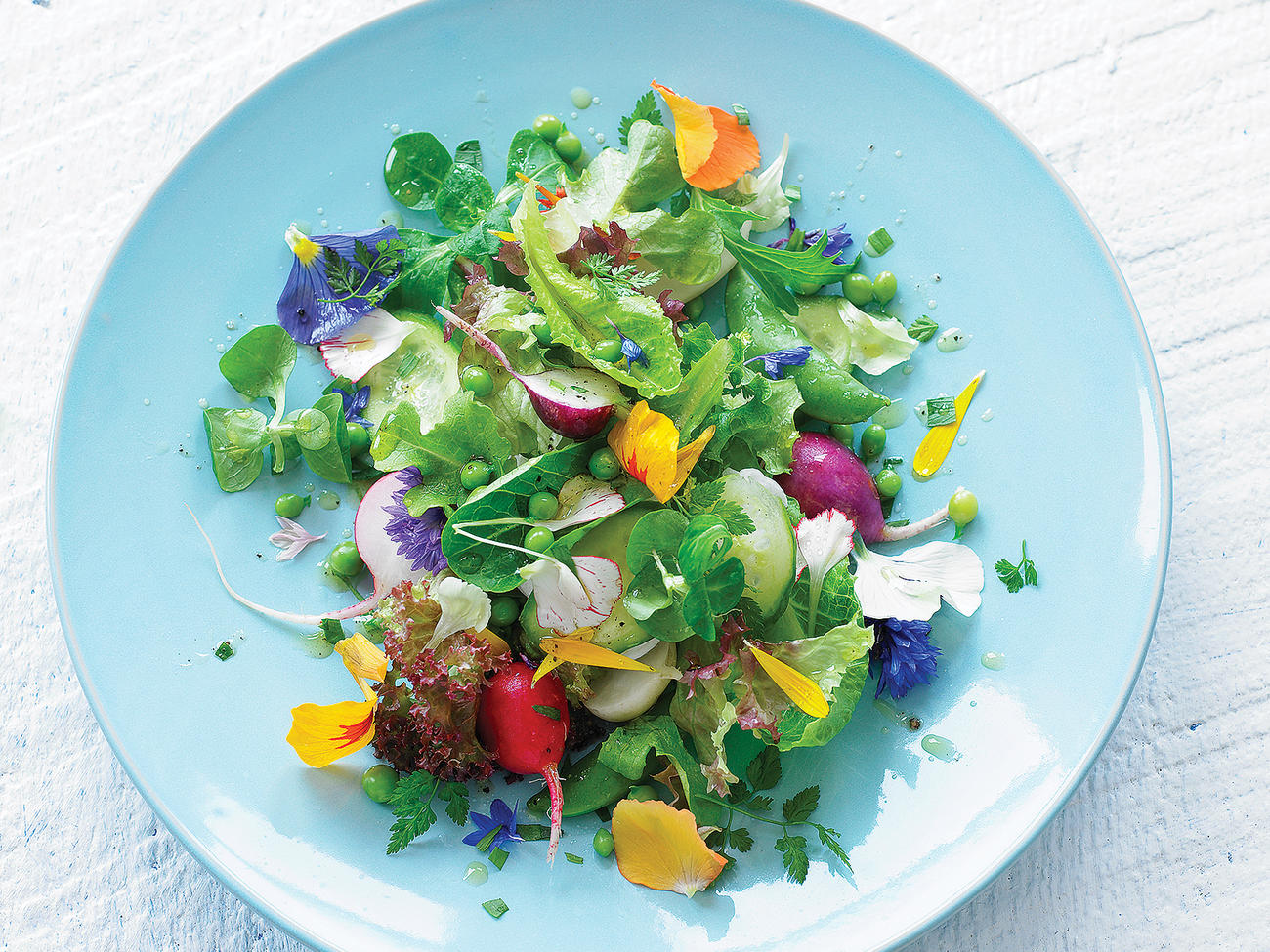
Eat-Your-Garden Salad

Recipe: Eat-Your-Garden Salad
When your garden gives you flowers and vegetables, use them both to make a salad that tastes like pure spring.
Ingredients you can grow in your flower bed:
Pansy petals
The largest of the viola-type flowers, all of which you can eat (the littlest are Johnny-jump-ups). Faint lettucelike taste; velvety texture.
Carnation petals
Sweet and spicy. Eat only the petals, and taste each flower before using, as they can sometimes
be bitter.
Calendula petals
Usually orange or yellow, with a daisylike appearance; mildly tangy.
Spiky-looking but soft; can be blue, purple, pink, rose, or white. Cucumberish flavor and a fun, frilly texture.
Nasturtium petals
The tastiest flower. Peppery and mustardy, with a touch of honey. Ranges from yellow to reddish orange, with variegations too.
Next: How to grow our favorite salad flowers
Our favorite salad flowers and how to grow them
Bachelor’s button (Centaurea cyanus)
Flavor/texture: Cucumberish, with a fun, frilly texture. Can eat either the whole bloom or the petals only.
Growing tips: Annual. Sunset climate zones 1–24, H1, H2. Full sun. Moderate water. Upright growth to 1 ½ ft. Narrow, gray-green leaves and flowers about 1 ½ inch across in shades of blue, purple, pink, rose, and white. More compact varieties, such as ‘Jubilee Gem’, are also available. Sow seeds in autumn in the desert, elsewhere in spring.
Borage (Borago officinalis)
Flavor/texture: Delicate cucumber taste, with hints of melon. To eat, pull out the hairy sepals in the center. The leaves are edible as well, though older ones have unpleasant spines.
Growing tips: Annual. Zones A2, A3, 1–24, H1. Full sun or light shade. Moderate water. Tolerates poor soil. Clump-forming European herb with rough-haired gray-green leaves and sprays of star-shaped true blue flowers. Reseeds abundantly, but doesn’t transplant well because of its deep taproot. Start from seed in spring after frost damage is past. Good cut flower too.
Calendula (Calendula officinalis)
Flavor/texture: Mildly tangy; thin, paperlike petals. Best eaten as petals.
Growing tips: Annual. Zones A2, A3, 1–24, H1. Full sun. Moderate water. Prefers rich soil but will tolerate other types if it has good drainage. Its daisylike orange and yellow flowers add glowing color to the garden over a long period ― late fall through spring in mild-winter areas, and from spring through midsummer in colder climates. Long-lasting cut flowers, too. Sow seed in place in late summer or early fall in mild-winter climates (spring elsewhere), or buy nursery seedlings.
Carnation (Dianthus)
Flavor/texture: Sweet and spicy. Best to eat only the petals; taste each flower, as some are bitter.
Growing tips: Annuals, biennials, perennials. Zones A2, A3, 1–24 for most species. Full sun; afternoon shade in the desert. Regular water. Most like light, fast-draining soil and neutral to slightly alkaline conditions. Plants vary from rock-garden miniatures to tall cut-flower types. Flowers are single, semi-double, or double, in shades of pink, rose, red, and white, often with fringed edges and/or contrasting eyes and margins. Many are highly fragrant. Plants are widely available in nurseries in spring; in mild climates also in fall. Species Dianthus are also easy to grow from seed.
Herb flowers (basil, chives, oregano, rosemary, sage)
Flavor/texture: They taste like the herb’s leaves, but often with a touch of sweetness. They can be tiny and delicate, so pick right before using, or snip the entire blossom stem and put it in water until ready to use.
Growing tips: Most of the common perennial culinary herbs are Mediterranean in origin. Their frost tolerance varies, but otherwise their needs are similar ― full sun, good drainage, and light to moderate irrigation. Annual culinary herbs generally need more water and perform better in enriched soil, especially herbs of tropical origin, such as basil. Although a perennial, garlic chives also need regular water.
Nasturtium (Tropaeolum majus)
Flavor/texture: Hands down the tastiest flower. Peppery and mustardy, with a honeyed undertone. Colors range from yellow to reddish orange, with variegations too. The petals are thin and fragile, and seem to melt on the tongue. The peppery leaves are edible too.
Growing tips: Annual. All zones. Full sun or light shade. Regular water. Needs well-drained soil; sandy is preferred. There are two types; the more commonly grown dwarfs, which are compact (1 ½ ft. high and wide) and bushy; and the climbing types, which trail over the ground or climb via coiling leafstalks to 6 ft. In mild-winter, hot-summer areas, sow seeds in fall; elsewhere, sow in early spring.
Stock (Matthiola incana)
Flavor/texture: Use flowerets. Warmly spicy flavor.
Growing tips: Short-lived perennials grown as annuals. Zones 1–24. Full sun to light shade. Regular water. Likes moderately rich soil with good drainage. Plants are bushy and upright and have lance-shaped gray-green leaves and clove- and cinnamon-scented single or double flowers in shades of white, cream, pink, red, and purple. Plant nursery seedlings in early spring in cold winter climates; early fall in mild winter climates.
Violas, including pansy (Viola cornuta, V. x wittrockiana) and Johnny-jump-up (V. tricolor)
Flavor/texture: Faint lettucelike taste; velvety texture. All are edible (pansies are the largest; the littlest are Johnny-jump-ups).
Growing tips: Perennials usually grown as annuals. Violas and Johnny-jump-ups grow in all zones; violas 1–10, 14–24. Full sun to partial shade. Regular water. Prefer rich, well-drained soil. Low-growing bushy plants with five-petaled flowers. Violas come in many solid colors as well as “whiskered” patterns; larger-flowered pansies often have dark, velvety blotches, creating the familiar pansy “face”; Johnny-jump-ups have tiny ½-inch-wide purple-yellow or blue-yellow flowers, and bloom profusely. Set out nursery plants in spring in cold-winter climates; plant in autumn in mild climates.
–Sharon Cohoon
